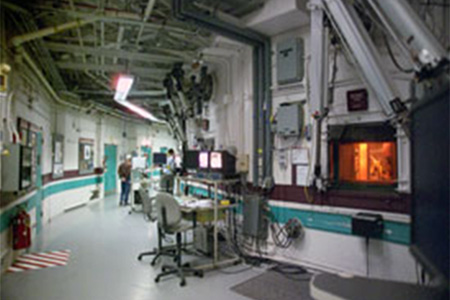Safeguarding Nuclear Fuel Processing
Photo courtesy by Idaho National Laboratory
The Data Collection System incorporating the use of camera technology within a hot cell environment to detect and deter the proliferation of special nuclear materials.
Idaho National Laboratory (INL) has undertaken an effort to develop a standard safeguards approach for international commercial pyroprocessing facilities. Large-scale investment in pyroprocessing facilities will become acceptable only if comprehensive safeguards are established to meet the International Atomic Energy Agency’s (IAEA) standards for detecting the diversion of significant quantities of nuclear material in a timely manner.
Why it Matters
The current increased global interest in pyroprocessing and pyroprocessing safeguards and nonproliferation issues has led to a demand to inform various government agencies about the technical aspects of pyroprocessing so that they can perform their assigned duties. INL is assisting the IAEA in developing safeguards for pyroprocessing facilities to minimize the threat of nuclear proliferation. The present-day, lack of agreed-upon comprehensive safeguards approach that can meet the IAEA goal quantity and timeliness criteria for pyroprocessing facilities was the driver for INL’s research efforts in this area. Without it, the IAEA cannot determine that the state is in compliance with its treaty obligations for the peaceful use of nuclear material.
Methods
A component by component diversion pathway analysis led to insights on the mitigation needs and equipment development needed for a valid safeguards approach. The effort to develop an in-hot cell detection capability led to the digital cloud chamber, and the scientific breakthrough of the inverse spectroscopy algorithms, including the ability to identify energy and spatial location of gamma ray emitting sources with a single, non-complex, stationary radiation detector system.
Curium measurements were performed on historical and current samples to determine the utility of using gross neutron counting for accountancy measurements. A solid cost estimate of equipment installation at the INL Fuel Conditioning Facility (FCF) has been developed to guide proposals and cost allocations to use the FCF as a test bed for safeguards measurement demonstrations.
A combined MATLAB and MCNPX model has been developed to perform detector placement calculations around the electrorefiner. Early harvesting has occurred wherein the project team has provided pyroprocessing technology and safeguards short courses.
What’s Next
The next steps for this project are to complete an approach for commercial reprocessing as well as securing international engagement with the Republic of Korea and the IAEA.
Acknowledgments
INL team members include Robert Bean, Richard Metcalf, David Gerts and his team (Terri Knudsen, Marc Paff, Hugh Wimberly, Nathan Fredette, Warren Jones, and Alan Mecham), Michael Simpson, Guy Fredrickson, Dee Vaden, Steve Hermann, Greg Teske, Tom Johnson, Ken Marsden, Chuck Solbrig, Alice Tomanin, James West, Brian Castle, and Sean Morrell.
Publications
Gerts D, M Paff, and R Bean. 2010. “Nuclear Material Accountability Applications of a Continuous Energy and Direction Gamma Ray Detector.” INMM Annual Meeting, Baltimore, MD, July 11-15, 2010.
Gerts D, H Wimberly, and N Fredette. 2010. “Using GPU Programming for Inverse Spectroscopy.” INMM Annual Meeting, Baltimore, MD, July 11-15, 2010.



